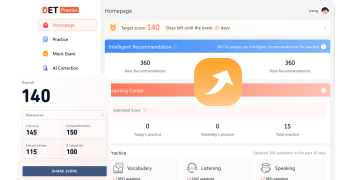Padroneggiare la sfida 'Leggi, poi scrivi' nel test di inglese Duolingo
Benvenuti, appassionati della lingua inglese e aspiranti al Duolingo English Test! Oggi ci immergiamo nella sezione ‘Read, Then Write’ del DET, una parte cruciale dell'esame che valuta la tua capacità di comprendere e scrivere in inglese in modo efficace. Molti trovano questa sezione intimidatoria a causa delle limitazioni di tempo e della profondità di risposta richiesta. Non temere! Questo post è la tua guida strategica per affrontare questa sezione con fiducia e padroneggiarla.
Il compito ‘Read, Then Write’ ti presenta un prompt a cui dovrai rispondere in 5 minuti. Sembra impegnativo, vero? Ma con l'approccio giusto, puoi trasformare questa sfida in un'opportunità per dimostrare le tue competenze in inglese. Che tu sia un parlante esperto di inglese o uno studente di lingue, questa guida ti offrirà strategie pratiche, suggerimenti per la gestione del tempo e persino modelli di risposta per assicurarti il successo. Quindi, intraprendiamo questo viaggio insieme e trasformiamo la tua scrittura da buona a eccellente!
Resta sintonizzato per suggerimenti preziosi su come comprendere i prompt, strutturare le tue risposte, arricchire il tuo vocabolario e molto altro, completi di modelli adattabili per guidare la tua pratica nella giusta direzione. Sei pronto a eccellere nella sezione ‘Read, Then Write’? Iniziamo!

1. Comprendere il Prompt: La Chiave per una Risposta Mirata
Immergersi nella sezione ‘Read, Then Write’ inizia con un passaggio cruciale: comprendere il prompt. Questa sezione richiede non solo le tue abilità linguistiche ma anche il tuo acume analitico. Ecco come assicurarsi di essere sulla strada giusta:
Per prima cosa, analizza il prompt. Scomponilo nei suoi componenti fondamentali. Qual è l'argomento principale? Ci sono dettagli specifici o confronti richiesti? Identificare questi elementi è essenziale per una risposta pertinente.
In secondo luogo, individua il tipo di domanda. Chiede una risposta descrittiva in cui illustrare idee con esempi, oppure è argomentativa dove prendi una posizione? Il tuo approccio dipenderà da questa distinzione.
Infine, presta attenzione alle parole direttive. Parole come ‘describe,’ ‘compare,’ o ‘argue’ ti danno un'idea diretta di ciò che gli esaminatori cercano. Ignorarle potrebbe portarti fuori strada.
Prendi ad esempio il prompt: “Parla dell'ultima volta in cui hai avuto paura di fare qualcosa di nuovo, ma l'hai fatto comunque. Come hai trovato la forza per provarci? Cosa hai imparato da questa esperienza che ti aiuterà nella vita?“
Per analizzarlo, identifica i tre componenti chiave: un'esperienza personale di paura, il superamento di quella paura e la lezione di vita appresa. È descrittivo ma anche riflessivo, richiedendo non solo il racconto di un evento ma anche un'introspezione personale.
Individua le parole d'azione: talk,’ ‘found the strength,’ e ‘learned.’ Queste ti indirizzano a condividere una narrazione, riflettere sulla tua resilienza interiore ed estrapolare una lezione di vita più ampia.
Ricorda, un prompt del genere non chiede solo cosa è successo. Invita a narrare un percorso e riflettere sul suo impatto. Comprendendo appieno questo, la tua risposta non solo racconterà una storia ma offrirà anche un assaggio della tua crescita personale, allineandosi perfettamente con ciò che il prompt cerca.
Ricorda, il prompt è la tua mappa stradale; comprenderlo non è solo il primo passo—è la base di una risposta convincente che risuonerà con gli valutatori. Quindi, prenditi un momento, leggilo attentamente e lascia che la chiarezza guidi la tua penna!
2. Padronanza della Gestione del Tempo:
Padroneggiare la gestione del tempo è fondamentale quando si hanno solo cinque minuti per rispondere. Ecco una suddivisione strategica:
Pianifica Velocemente: Dedica un minuto a brainstorming e delineare. Annota le tue idee e i punti che vuoi toccare.
Scrivi Efficientemente: Destina tre minuti alla scrittura. Attieniti al tuo schema e mantieni le frasi concise. Punta alla chiarezza e precisione.
Correggi Efficacemente: Riserva l'ultimo minuto per la correzione. Controlla gli errori grammaticali, assicurati di aver risposto a tutte le parti del prompt e affina eventuali espressioni goffe.
Strutturando il tuo tempo saggiamente, assicuri che la tua risposta sia coerente, pulita e completa. Ricorda, una risposta lucida entro il limite di tempo è meglio di un capolavoro incompiuto.
3. Strutturare la Tua Risposta: Mantienila Semplice e Chiara
Avendo solo 5 minuti per la sezione ‘Read, Then Write’, la semplicità è la chiave. Ecco come strutturare una risposta chiara ed efficace:
Introduzione: Inizia con una frase semplice che affronta direttamente il prompt. Se il prompt riguarda un'esperienza personale, inizia con una dichiarazione concisa che imposta la scena.
Parte Principale: Scegli uno o due punti principali da sviluppare. Se stai descrivendo un'esperienza, concentrati sulla parte più impattante. Se stai argomentando un punto, esponi la tua ragione principale e supportala brevemente.
Conclusione: Termina con una breve chiusura che riflette sull'esperienza o ribadisce il tuo punto. Falla risuonare ma mantienila succinta.
Questa struttura semplice assicura che la tua risposta sia organizzata e che tu rimanga focalizzato sul prompt, sfruttando al massimo il tempo limitato.
Con il prompt “Talk about the last time you felt scared to do something new, but you did it anyway. How did you find the strength to try it? What did you learn from this experience that will help you in life?“, dimostriamo una struttura semplice:
Introduzione: “Facing my long-standing fear of heights, I decided to try rock climbing, an activity that both terrified and intrigued me.”
Parte Principale: “Initially, the very thought of climbing filled me with dread. However, recognizing the importance of confronting my fears, I started with small, manageable climbs. I sought guidance from experienced climbers and gradually built my confidence through their support and my persistent practice. This journey was not just about climbing but about learning to trust in my abilities and the support of those around me. The moment I reached the top of my first significant climb, the overwhelming sense of achievement eclipsed any fear I had felt.”
Conclusione: “This experience taught me that facing fears head-on, with preparation and support, can lead to profound personal growth.”
Questo esempio si attiene alla semplice struttura di introduzione, corpo e conclusione, adattando una risposta coerente e impattante in un formato conciso adatto al compito di scrittura di 5 minuti.
4. Profondità Piuttosto che Ampiezza: Creare Risposte Ricche
Concentrarsi sulla profondità piuttosto che tentare di coprire troppo è vitale per la sezione ‘Read, Then Write’. Questo significa scegliere uno o due punti chiave e esplorarli in dettaglio. Usa esempi specifici e intuizioni personali per fornire una risposta ricca e sfumata. Questo approccio non solo dimostra la tua capacità di pensare in modo critico e riflessivo, ma assicura anche che la tua scrittura sia coinvolgente e significativa. Mira a mostrare una comprensione profonda dell'argomento, che farà risaltare la tua risposta agli occhi degli esaminatori.
5. Linguaggio e Vocabolario: L'Arte della Precisione e Varietà
Utilizzare un vocabolario vario e preciso è cruciale nella sezione ‘Read, Then Write’. Mira a usare parole specifiche ed espressive che trasmettano accuratamente i tuoi pensieri ed emozioni. Questo non significa ricorrere a termini eccessivamente complessi o oscuri che potrebbero confondere il lettore. Invece, cerca chiarezza e precisione nella scelta delle parole. Usare i sinonimi in modo ponderato può aggiungere ricchezza al tuo testo senza compromettere la comprensibilità. Inoltre, una grammatica corretta e una struttura delle frasi adeguata sono essenziali per comunicare efficacemente le tue idee e fare una buona impressione sugli esaminatori.
Per affinare la risposta utilizzando un vocabolario vario e preciso, puoi considerare i seguenti miglioramenti:
Introduzione: “Confronted by my perennial dread of altitudes, I embraced rock climbing, a venture that both daunted and captivated me.”
Parte Principale: “The notion of ascending vertical faces initially paralyzed me with fear. Acknowledging the necessity to confront my apprehensions, I embarked on modest ascents, under the tutelage of seasoned climbers. Their mentorship, coupled with my steadfast dedication, gradually fortified my confidence. This odyssey was not merely about climbing; it was an expedition in self-discovery and trust. Achieving the summit of my inaugural significant climb was a testament to surmounting fears through perseverance and communal support.”
Conclusione: “This odyssey illuminated the essence of bravery, tenacity, and the significance of stepwise progression. It underscored that engaging directly with one’s fears, equipped with preparation and camaraderie, catalyzes profound self-evolution. These lessons serve as invaluable compasses for navigating future adversities with a fortified resolve.”
Questa versione sfrutta un vocabolario più ricco e un linguaggio più descrittivo per trasmettere l'esperienza in modo vivido e riflessivo, dimostrando come la scelta precisa delle parole migliori la profondità e l'impatto della narrazione.
6. Modelli per il Successo: Approcci Strutturati per Diversi Tipi di Domande
Per affrontare efficacemente le domande ‘Read, Then Write’, considera questi semplici modelli adattati per prompt descrittivi e argomentativi:
Modello per Prompt Descrittivi:
- Introduzione: Introduci brevemente la situazione o l'esperienza.
- Parte Principale: Descrivi l'esperienza con dettagli specifici, concentrandoti su informazioni sensoriali ed emozioni per dare vita alla storia.
- Conclusione: Riflettici sopra, enfatizzando la crescita personale o le intuizioni ottenute.
Modello per Prompt Argomentativi:
- Introduzione: Esprimi chiaramente la tua posizione.
- Parte Principale: Presenta uno o due argomenti forti supportati da esempi o prove.
- Conclusione: Rafforza la tua posizione, riepilogando come i tuoi argomenti la supportano.
Questi modelli servono come progetti per costruire risposte chiare e mirate. Ricorda, personalizzare in base al prompt è la chiave per fornire una risposta convincente.
7. Pratiche di Correzione: Migliorare la Qualità Attraverso l'Attenzione ai Dettagli
La correzione è l'ultimo, cruciale passaggio per assicurarti che la tua risposta ‘Read, Then Write’ risplenda. Questa fase non consiste solo nel cercare refusi; è una revisione completa per migliorare chiarezza, coerenza e impatto. Dedica almeno un minuto a questo processo, seguendo questi passaggi:
1. Verifica la Completezza: Rileggi il prompt per confermare che la tua risposta affronti tutti gli aspetti. Mancare una parte della domanda può influire significativamente sul tuo punteggio.
2. Revisione di Grammatica e Sintassi: Cerca gli errori grammaticali comuni come l'accordo soggetto-verbo, l'uso scorretto dei tempi e i modificatori fuori posto. Assicurati che le tue frasi scorrano fluidamente e che l'uso della punteggiatura migliori la leggibilità.
3. Vocabolario e Chiarezza: Verifica che le tue scelte di parole siano precise e appropriate per il contesto. Sostituisci i termini vaghi con quelli specifici per aggiungere profondità alla tua narrazione o argomento.
4. Flusso Logico: Valuta l'organizzazione delle tue idee. Assicurati che ogni paragrafo transizioni fluidamente al successivo, mantenendo una progressione logica del pensiero.
5. Elimina Ridondanze: Rimuovi affermazioni ripetitive o parole superflue. La concisione è la chiave per una scrittura chiara e potente.
6. Leggi a Voce Alta: Sentire il tuo testo può rivelare espressioni goffe ed errori trascurati che la lettura silenziosa potrebbe non individuare.
7. Ultimo Sguardo per l'Ortografia: Anche con il controllo ortografico, alcuni errori possono sfuggire, specialmente con omofoni o scelte di parole errate che sono comunque parole valide.
Integrando queste pratiche di correzione, la tua risposta non solo sarà grammaticalmente corretta, ma anche più coinvolgente ed efficace. Questo processo di raffinamento meticoloso può elevare la tua scrittura, lasciando un'impressione duratura sugli valutatori.
In questa guida completa, abbiamo esplorato strategie essenziali e modelli pratici per navigare efficacemente la sezione ‘Read, Then Write’ del Duolingo English Test. Dalla decodifica dei prompt con precisione alla gestione giudiziosa dei tuoi preziosi cinque minuti, strutturando le risposte per evidenziare chiarezza e profondità, migliorando la tua narrazione con un vocabolario vario, e affinando il tuo bozza con una correzione diligente—ogni strategia gioca un ruolo cruciale nella creazione di una risposta convincente. Ricorda, l'eccellenza in questo segmento deriva da una pratica costante e dall'applicazione ponderata di queste tecniche. Ti incoraggio a integrare queste strategie nella tua routine di preparazione, affinando progressivamente le tue abilità. Lascia che ogni sessione di pratica sia un passo verso non solo raggiungere ma superare i tuoi obiettivi di scrittura, portandoti al successo nel DET.
Clicca qui per ulteriori Strategie di Preparazione al DET
Stai cercando consigli sul DET? Scopri qui: https://www.detpractice.com/category/pro-test
tips/
Inizia a praticare oggi iscrivendoti gratuitamente al nostro DET question bank.






